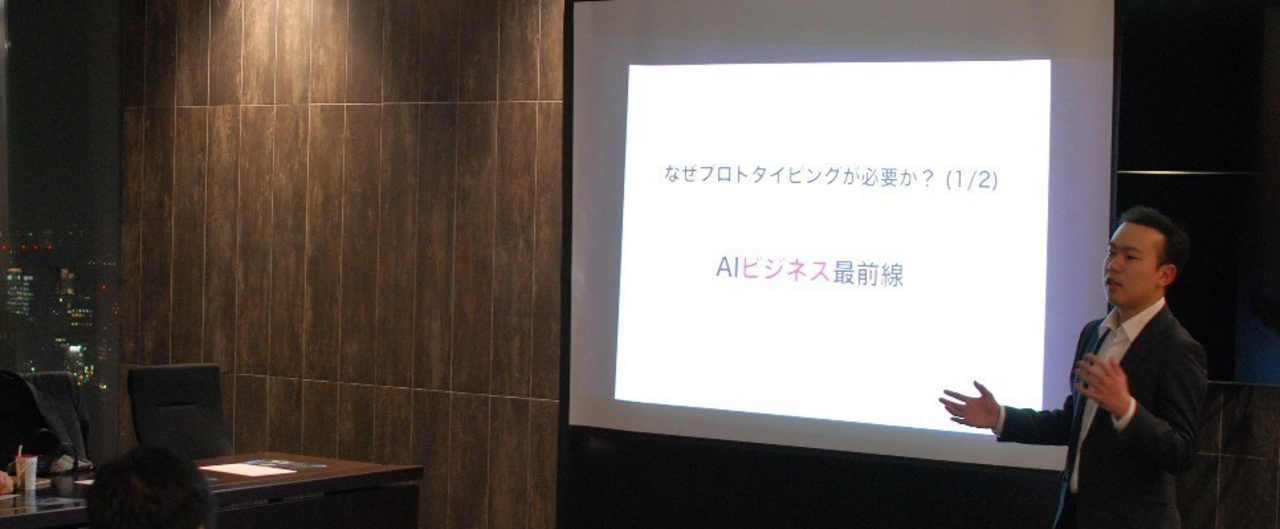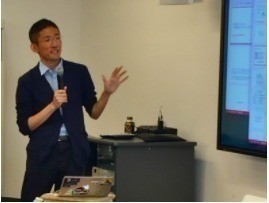勉強の為に転載しました。
https://note.mu/datastrategy/n/nbbf724464d77

2017年はAI(Artificial Intelligence)に関するさまざまなツールが発表され、ビジネスにAIを組み入れる必要性が強く意識された年でした。また多くの企業が、ビジネスにどうAIを活用すればよいかを検討しはじめた年でもありました。2018年は、実行段階に移行する企業も増え、AIによるビジネスへのインパクトを実感できるシーンも増加すると思います。
この記事では、AI・データ導入戦略を手掛けるDataStrategy株式会社と、AIプロトタイピングサービスを提供するAnyTech株式会社が、手掛けてきた多くのプロジェクトの中でうまくいかないプロジェクトの傾向を洞察し、成功に向かうヒントを対談形式で分析してみました。特に「導入の失敗」に焦点を当てています。
記事は前半後半の2部構成で、前半はよくある失敗の原因、後半は「こうすれば良くなる」という経験に基づいた内容となっています。AIを導入してみたものの、なかなかうまくいかないと悩んでいる方たちの参考になれば幸いです。
武田 元彦
DataStrategy株式会社 代表取締役
https://datastrategy.jp
東京大学大学院修了(経済学修士)。株式会社三菱総合研究所、NPO団体、フリーランスを経て現職。これまでに、携帯キャリア大手・商業銀行・技術系ベンチャー企業などでのデータ解析支援、技術コンサルティング、マーケティング戦略策定支援を経験。機械学習・人工知能モデルの開発、サービスプロトタイプの開発などにも従事。
DataStrategy株式会社 代表取締役
https://datastrategy.jp
東京大学大学院修了(経済学修士)。株式会社三菱総合研究所、NPO団体、フリーランスを経て現職。これまでに、携帯キャリア大手・商業銀行・技術系ベンチャー企業などでのデータ解析支援、技術コンサルティング、マーケティング戦略策定支援を経験。機械学習・人工知能モデルの開発、サービスプロトタイプの開発などにも従事。

島本 佳紀
AnyTech株式会社 代表取締役
https://www.anytech.io/
1986年7月1日生。早稲田大学大学院修了(工学修士)。株式会社リクルートテクノロジーズのビッグデータ部など複数の企業で開発に従事。IBM 主催の Watson 開発コンテストでアプリ賞を受賞。AnyTech株式会社を設立し、AIプロトタイピングサービス「AnyTech」を提供。日本初のAIベンチャー支援プログラム「AI.Accelerator(エーアイアクセラレータ)」や、リクルートが運営するアクセラレーター「 TECH LAB PAAK」に採択されている。
AnyTech株式会社 代表取締役
https://www.anytech.io/
1986年7月1日生。早稲田大学大学院修了(工学修士)。株式会社リクルートテクノロジーズのビッグデータ部など複数の企業で開発に従事。IBM 主催の Watson 開発コンテストでアプリ賞を受賞。AnyTech株式会社を設立し、AIプロトタイピングサービス「AnyTech」を提供。日本初のAIベンチャー支援プログラム「AI.Accelerator(エーアイアクセラレータ)」や、リクルートが運営するアクセラレーター「 TECH LAB PAAK」に採択されている。

上手くいかない理由は開発プロセスの考え方と開発ツールにあり
-- AIを導入してみた企業から「思っていたより難しかった」、あるいは「当初想定していたことができなかった」という話があります。実際に「こんなケースがあった」という話を聞かせてください。
島本:うまくいかない理由は2つあります。1つは開発期間が長期化してしまうこと、2つ目は開発ツールの選定です。
1つ目の長期化というのは、データが十分足りているかなどの検証を含めて最初から開発期間を大幅に取ってしまうことで、その後のプロジェクト進行がうまく回らず、結果として精度の良いエンジンが上がらないという状況があります。
-- 開発期間が短すぎるのではなくて、長すぎるということですか?
島本:そうです。恐らくこれまでの大規模な業務システム開発の考え方をベースに設計したケースがあるかなと思います。AI開発のプロセスはこれまでの大規模な業務システム開発のプロセスが大きく異なります。AI開発の場合、最初の段階で実際データをシステム化する前に完全に要件を定義しきるのが難しいと思います。業務システムとなるとやはりなかなか小さい変更やエラーも許容できないケースもあり、それによってシステム要件をガチガチに決めるということがあると思いますが、そこが大きく変化しているのではないでしょうか。
-- 業務システム開発プロジェクトでは合間に中間成果物やマイルストーンのようなものを置くのが定石ですが、AI導入にも当てはまるのでしょうか?
島本:そこも違います。システム開発では「いつまでにこの機能を」というマイルストーン(進捗管理のために途中で設ける節目)の置き方ができると思います。しかし、AI開発の場合はいったん形にしてからチューニングといったフローになっています。マイルストーンは置けますが考え方は変わってきますね。
適切な開発期間ではない事案は、大手企業に多いです。有名企業はそれまでの得意先との長年の付き合いもあり、名の知れたところと仕事をすることが多くなります。そうすると、これまで業務システムを得意としている開発会社と組んだ場合に、このようなことが起きることが多いです。
2つ目の開発ツール選定ですが、開発企業によっては既にあるツールやエンジン以外はあまり使わないという縛りがあったりします。開発企業がどこかとパートナー契約を交わしている事例もあります。そのツールを使わないといけないという縛りの中で実際に作ろうとしているものに最適化できないケースがあります。
僕たちは既存ツールの強みや弱みを知っているので、その相談から始まり、以降のプロジェクトを進めることもあります。さまざまなツールを使えることがAnyTechの魅力として映っているのかもしれません。
導入対象の選定や、期待値コントロールに原因があることも
-- なるほど。武田さんはいかがでしょうか。
武田:うまくいかないケースは大きく3パターンあると考えています。
1つ目は、「作ってみた、導入してみたけれど精度が上がりません」です。理由はケースバイケースですが、そもそも「当てるのがかなり難しいものを当てようとしている」とか、データ収集方法が適切ではないことが挙げられます。
2つ目はそれと関連しますが「作ったけれど、想定していた人や社内の人、あるいはお客さまに使ってもらえない」ということです。使ってもらえないときは、精度の問題であれば精度改善が必要ですし、UI・UXに問題があることもあります。
また、期待値を下げるというのも有効なアプローチだと考えています。たとえば、お客さま対応のChatbotだとそれなりに高い精度が求められますが、マイクロソフトの女子高生AIりんななどは、うまく期待値を下げている例だと思います。多少おかしなことを言っても許される設計ですね。業務プロセスのなかで、期待値が低いところ、ある程度間違いが許容されるところから始めていくというのも、アプローチとしては有効だと思います。
-- 期待値を下げるというのは後ろ向きに聞こえるのではないでしょうか?
武田:いえいえ、その取り組みを続けて、どんどん精度が上げられれば良いかなと思います。最初狙った精度はいきなり出ないので、できるだけの期待値に下げて評価データを集め、徐々に事業インパクトが出るような精度を目指して上手くいくことが多いです。
武田:そのほか、3つ目としてよく聞く話は「外部のAIが入っているサービスを買ったのだが思うように使いこなせない」ということです。それもAI導入の中の問題の1つとしてはあります。
価値のあるなかなか共有されない失敗例
-- 実現したいことに対して、どの程度の精度が達成できそうかを判断することは難しいことのように思いますが、分かるものなのでしょうか。
武田:勿論精度担保をすることは困難ですが、モデルを作ったことがある技術者が見れば、見当はつけられます。全く無理か、頑張れば何とかなるか、は経験的に肌感覚で分かると思います。
判断基準の1つとして、人間が判断できないようなものは結構難しいと思います。過去の大手企業の事例でも、人間でも判断できないようなものを判断させることを目標として、うまくいかなかったケースが散見されました。失敗は当然ですが、なかなか外に言わないですよね。よほど大規模な失敗なら耳に入ることもあるかもしれません。
島本:今回AIに特化したアクセラレータ・プログラムに参加しましたが、とても新鮮で刺激を受けました。各社AI系のスタートアップは、初期に受託で立ち上がっている会社が多いので、割とどこでも失敗経験があるようですが、そのあたりはオンラインには出てきていないようです。狭いコミュニティーでは共有されることもあるので、その失敗例の情報は重要だと感じました。
* 対談は後半へ続きます。後半の記事はこちら
---
DataStrategyへ相談したい方へ
DataStrategyでは、執筆、イベント登壇、取材、サービスの改善、アドバイザリーなどの相談を受け付けています。弊社へまずは相談だけでもしてみたい、一度話を聞いてみたいという方は twitter (@motohikotakeda) でDMして下さい。
・AI可能性診断 https://datastrategy.jp/aikanousei/
・弊社ウェブサイト https://datastrategy.jp
・資料請求 https://datastrategy.jp/document/
・弊社ウェブサイト https://datastrategy.jp
・資料請求 https://datastrategy.jp/document/
勉強の為に転載しました。
武田 元彦 / DataStrategy Inc. CEO
フリーのデータサイエンティストを経て、新規事業開発や業務自動化、データ駆動型マーケティングのための技術導入全般をディレクションするDataStrategy創業。帝京大学講師(マーケティングサイエンス)、ナレッジ・マーチャントワークス株式会社社外取締役(データサイエンス担当)
プランニングをいかに適切にできるかが最重要。うまくいっていない場合でも再プランニングを検討する
-- 今度は「こうやれば、うまくいった」「うまくいく」というご自身の経験からお話しいただければと思います。
武田:事前のプランニングが一番重要だと考えています。こういうデータと技術があれば、これぐらいの精度のものはできそうだ、ということを事前にプランニングして、検証し、実際に使えるものを開発していく、というところが重要ですね。
タスク設定が難しければ精度は出ませんし、精度が出ても事業(P/L)へのインパクトがなければ、後から振り返ったときに「なんだったのだろう?」ということになりかねません。精度が出そうか、事業インパクトがありそうかという視点でタスク設定をする必要があります。
AI導入の事業へのインパクトの出し方としては、大きくいうと顧客向け(プロダクトに組み入れる)と社内向け(コスト削減)に分類されます。顧客向けであればAIに求められる精度水準も高くなりますが、社内向けであれば、AIを単独で使うのではなく、AIと社内人員とを組み合わせて行うことで、結果として業務の精度を上げたり効率を上げたりといったこともあります。
今あるデータや技術をもとに、どの程度の水準であれば達成できそうか、そのためにはどう事業に組み込むかを適切に設計する必要があります。
島本:結局僕もプランニングの話になってしまいます。プランニングというものの中に、しっかりした検証やPoC(Proof of Concept、概念実証のための試作品を作ること)の開発を組み込んだプランニングと捉えることが大事だと考えています。
従来のプランニングはあくまで開発着手する前のものという認識で、計画をしっかりと練ってから作り始めていくというのが一般的です。しかし、AI開発の場合はPoCを作ることでようやくある程度確度のあるプランニングができるので、「プランニングの中にPoCはある」という前提でプロジェクトを進めるのが重要だと考えています。そうしないと最初のプランニングが机上の空論になってしまい、ズレた予算・期間・精度と全体的にズレたものになってしまうこともあり得ます。
-- 例えば「AI導入を既に実施しているがうまく精度が上がらない」場合は、どうしたらよいでしょうか?
武田:3ステップあります。人間がやっている判断を再現することが精度向上の近道なので、まずは実際にその業務の現場担当者が何を見て判断しているのかをきちんと把握することです。それを踏まえて2つ目は、その人が判断材料としている情報を「きちんとデータ化して入れましょう」です。3つ目は、その上で「アルゴリズムを改善して頑張りましょう」です。
すごいアルゴリズムを開発できる人を連れてくれば精度が上がるのでは、と一般的には思われるかもしれません。もちろんそれも大事です。しかしデータがダメだとアルゴリズムでどう頑張っても難しいので、まずはデータをリッチにしてアルゴリズムを頑張る、というのが王道です。
島本:僕も2つあって、チューニングの方法を再検討する、見直すということがあります。チューニングは、かなり人力というか、属人(その人に属すること)的な部分も多いし、この事業だったらこの方法が良いという正解があるわけでもないので、そこは再検討の余地がありますし、違う手法をもっている企業に相談に行くという手もあるかもしれません。
2つ目は逆にチューニングの問題ではない場合も多々あるので、最初の設計から見直すという、事業の意思決定としてはかなり痛手というか損切りとして痛いのですが、その方がスムーズにいくというパターンもあります。この点に関しては、逆に従来のシステム開発に近いかもしれません。途中まで作ってしまったけれど、そもそも設計が良くなかったということになります。
AI開発パートナー選びの重要性
-- 実際AI開発を進める場合にパートナーが必要になることも多いと思いますが、AI開発のパートナー選びについて教えていただけますか?
武田:AIの技術は非常に幅広くて、かつ日々進化しています。AIに関連したデータ分析ができる人材も非常に人気で、需給が逼迫(ひっぱく)しているという状況を踏まえると、AI導入に関して必要な知識や人材を一つの会社内で賄うのは非現実的になっていると思います。
無理に全部自社で実行しようとせずに、適切なタイミングで適切なパートナーを選び、良い意味で「使っていく」というのが必要だと思います。
また、「良いベンチャー企業にアクセスできない」という話もよく聞きます。そもそもどこが技術をもっているか分からない。そうならないためにも、普段から良いコミュニティーにアクセスすることは重要だと思っています。技術をもったベンチャーの周りには、きちんと技術をもったベンチャーがいますし、技術をもったエンジニアの周りには、技術をもったエンジニアがいると思います。
島本:AnyTechはフリーランスや本業以外の仕事をするトップエンジニアのコミュニティー集団です。その経験から言うと、各専門家が必要だという話に加えて、さらに2つあります。
1つはその領域の失敗経験があるかどうか。技術力が高いところは失敗経験も豊富なので、それが1つのサイン(判断材料)になります。
もう1つは失敗だけでもよくないわけで、イテレーション(ソフトウエア開発、特にアジャイル開発における短い間隔で反復しながら行われる開発サイクルのこと)のサイクルが早いかどうかになります。1つのマイルストーンを達成するのに1年、2年と掛かるのではなく、そこを細分化してイテレーションを回していけるかどうかがよいパートナーの指標になるのかなと考えています。新しい技術が出てくるのも早いのでそれらを取り入れられるかどうかというのもイテレーションの早さであり、重要だと考えています。
AnyTechもさまざまな開発を通じて失敗経験を積んでおり、適切なサイクルの設定の勘所も分かる開発サービス集団です。
---
DataStrategyへ相談したい方へ
DataStrategyでは、執筆、イベント登壇、取材、サービスの改善、アドバイザリーなどの相談を受け付けています。弊社へまずは相談だけでもしてみたい、一度話を聞いてみたいという方は twitter (@motohikotakeda) でDMして下さい。
・AI可能性診断 https://datastrategy.jp/aikanousei/
・弊社ウェブサイト https://datastrategy.jp
・資料請求 https://datastrategy.jp/document/
・弊社ウェブサイト https://datastrategy.jp
・資料請求 https://datastrategy.jp/document/
Three reasons why AI adoption does not work (second half)" that data strategy companies think.
Reprinted for study.
https://note.mu/datastrategy/n/nbbf724464d77



https://note.mu/datastrategy/n/nbbf724464d77

2017 was a year in which various tools related to AI (Artificial Intelligence) were announced and the need to incorporate AI into business was strongly recognized. It was also the year that many companies began to consider how to utilize AI for their business. I think that in 2018, more companies will move to the execution stage, and there will be more scenes where you can feel the impact of AI on your business.
In this article, DataStrategy Co., Ltd., which handles AI and data introduction strategies, and AnyTech Co., Ltd., which provides AI prototyping services, gain insight into the tendency of projects that do not work well among many projects that they have worked on, and hints for success. I analyzed it in a dialogue format . In particular, it focuses on "deployment failures."
The article is divided into two parts, the first half and the second half. The first half is based on common causes of failure, and the second half is based on the experience that "this way it will be better". I would like to introduce it to people who have introduced AI but are worried that it will not work well.
Motohiko Takeda
DataStrategy Co., Ltd. President
https://datastrategy.jp
Graduated from the University of Tokyo (Master of Economics). Worked at Mitsubishi Research Institute, Inc., NPO group, and freelance before assuming current position. So far, he has experience in data analysis support, technology consulting, marketing strategy formulation support at major mobile carriers, commercial banks, and technology venture companies. Engaged in machine learning, artificial intelligence model development, service prototype development, etc.
DataStrategy Co., Ltd. President
https://datastrategy.jp
Graduated from the University of Tokyo (Master of Economics). Worked at Mitsubishi Research Institute, Inc., NPO group, and freelance before assuming current position. So far, he has experience in data analysis support, technology consulting, marketing strategy formulation support at major mobile carriers, commercial banks, and technology venture companies. Engaged in machine learning, artificial intelligence model development, service prototype development, etc.

Yoshinori Shimamoto
AnyTech Co., Ltd. Representative Director
https://www.anytech.io/
Born July 1, 1986. Completed graduate school at Waseda University (Master of Engineering). Engaged in development at several companies including the Big Data Department of Recruit Technologies Co., Ltd. App Award at the Watson Development Contest hosted by IBM. Established AnyTech Co., Ltd. and provided AI prototyping service "AnyTech". It has been adopted by Japan's first AI venture support program "AI.Accelerator" and accelerator "TECH LAB PAAK" operated by Recruit.
AnyTech Co., Ltd. Representative Director
https://www.anytech.io/
Born July 1, 1986. Completed graduate school at Waseda University (Master of Engineering). Engaged in development at several companies including the Big Data Department of Recruit Technologies Co., Ltd. App Award at the Watson Development Contest hosted by IBM. Established AnyTech Co., Ltd. and provided AI prototyping service "AnyTech". It has been adopted by Japan's first AI venture support program "AI.Accelerator" and accelerator "TECH LAB PAAK" operated by Recruit.

The reason why it doesn't work is because of the idea of the development process and the development tools
--There is a story from a company that introduced AI that it was "more difficult than I expected" or "I couldn't do what I had originally planned." Please tell us the story of “There was such a case”.
Shimamoto : There are two reasons why it doesn't work. The first is that the development period will be extended, and the second is the selection of development tools.
The first is to lengthen the development period from the beginning, including verification of whether data is sufficient, etc., and the subsequent project progress does not go well, resulting in an accurate engine. There is a situation where does not go up.
--Are the development periods not too short, but too long?
Shimamoto : That's right. Perhaps there are cases where the design was based on the idea of large-scale business system development up to now. The AI development process differs greatly from the conventional large-scale business system development process . In the case of AI development, I find it difficult to completely define the requirements before systemizing the actual data in the first stage. There are cases where even small changes and errors cannot be tolerated when it comes to business systems, and I think that there are times when system requirements are rigorously determined, but that may be a major change.
--In business system development projects, it is routine to put things such as intermediate artifacts and milestones in between, but is it also applicable to the introduction of AI?
Shimamoto : That is also different. In system development, I think we can put a milestone (a milestone to be set in the middle for progress management) called "By when this function will be used". However, in the case of AI development, the flow is such as tuning once it has been shaped . You can put milestones, but your thinking will change.
There are many cases in which large companies do not have the proper development period. Well-known companies have many years of relationships with their customers, and often work with well-known companies. This often happens when you work with a development company that specializes in business systems.
Regarding the second development tool selection, some development companies have a constraint that they only use tools and engines that they already have. There are also cases where the development company has a partner agreement with somewhere. There are cases where you cannot optimize for what you are actually trying to create, with the constraint that you have to use that tool .
Since we know the strengths and weaknesses of existing tools, we may start with the consultation and proceed with the subsequent projects. The use of various tools may be reflected in the appeal of AnyTech.
There may be a cause for the selection of the introduction target or the expected value control
-- So that's it. How about Mr. Takeda?
Takeda : I think there are three major cases that do not work.
The first is "I tried to make it, but I introduced it, but the accuracy does not improve." The reason is on a case-by-case basis, but in the first place, “I am trying to guess something that is quite difficult to guess” or that the data collection method is not appropriate .
The second is related to that, but it is "I made it, but I can't get it to be used by the people I was expecting, people in the company, or customers." If you can not use it, if it is a problem with accuracy, you need to improve accuracy, and there may be problems with UI and UX.
We also think that lowering the expected value is an effective approach. For example, a Chatbot that supports customers requires a high degree of accuracy, but I think Microsoft's high school girl AI Rinna is a good example of lowering expectations. It's a design that is acceptable even if it says something strange. I think it's an effective approach to start from a place where the expected value is low or a certain degree of error is allowed in the business process .
--Isn't lowering the expectation sounding backwards?
Takeda : No, I think it would be better if we could continue to work on this and improve the accuracy. The accuracy that we initially aimed for does not come up suddenly, so it is often successful to reduce the expected value as much as possible and collect evaluation data, aiming for accuracy that gradually produces a business impact.
Takeda : The third story I often hear is that I bought a service that has an external AI, but I can't use it as I want. That is also one of the problems in the introduction of AI.
Examples of failures that are not shared with value
-It seems difficult to judge how much accuracy you can achieve for what you want to achieve, but is it understandable?
Takeda : Of course, it is difficult to guarantee accuracy, but if you look at an engineer who has made a model, you can get an idea. I think that it is empirically clear that it is impossible to do it or if you try hard enough.
As one of the judgment criteria, I think it is quite difficult for people that cannot be judged. Even in the cases of large companies in the past, there were some cases where it did not work well with the goal of making things that humans could not judge. It is natural for me to make mistakes, but I don't quite say it out. A very large failure may be heard.
Shimamoto : I participated in an accelerator program specialized in AI this time, and it was very fresh and inspired. Many AI startups are starting out as consignment in the early days, so it seems that they have failed everywhere, but it seems that they have not appeared online. Since it may be shared in a small community, I felt that the information about the failure was important.
* The dialogue will continue to the second half. Click here for the second half of the article
---
For those who want to consult with DataStrategy
DataStrategy accepts consultations such as writing, event presentation, coverage, service improvement, advisory, etc. If you would like to talk to us first, or if you would like to hear the story, please DM us on twitter ( @motohikotakeda ).
・AI possibility diagnosis https://datastrategy.jp/aikanousei/
・Our website https://datastrategy.jp
・Document request https://datastrategy.jp/document/
・Our website https://datastrategy.jp
・Document request https://datastrategy.jp/document/
Reprinted for study.
Motohiko Takeda / CEO, DataStrategy Inc.
Founded DataStrategy, who is a freelance data scientist and directs the overall technology introduction for new business development, business automation, and data-driven marketing. Teikyo University Lecturer (Marketing Science), Knowledge Merchant Works Co., Ltd. Outside Director (Data Science)
*I 'm talking with Mr. Shimamoto, the representative of AnyTech , about the reasons why AI isn't working well . This article will come later. Part of the article is here from
The most important thing is how to plan properly. Consider replanning even if it's not working
--This time, I would like to talk about your own experience of "if you do this, it worked" and "it works."
Takeda : I think planning in advance is the most important. With such data and technology, it is important to plan in advance that it will be possible to achieve such accuracy and to verify it, and develop what can be actually used.
If task setting is difficult, accuracy will not come out, and if accuracy does come out and there is no impact on the business (P/L), when I look back later I might be wondering what was happening? not. It is necessary to set the task from the perspective of whether the accuracy is likely to occur or the business impact is likely.
The ways in which the impact of AI introduction on the business can be broadly classified into those for customers (incorporating into products) and those for internal use (cost reduction). For customers, the level of accuracy required for AI will also increase, but for internal use, using AI in combination with in-house personnel will improve the accuracy of work as a result, rather than using AI alone. There are times when you want to increase or increase efficiency.
Based on existing data and technology, it is necessary to properly design what level is likely to be achieved and how to incorporate it into the business.
Shimamoto : I ended up talking about planning. I think that it is important to consider it as planning that incorporates solid verification and development of a Proof of Concept (Procedure for Proof of Concept) into planning.
It is common to recognize that the conventional planning is just before the development is undertaken, and then carefully plan the plan before starting. However, in the case of AI development, it is possible to plan with a certain degree of accuracy only by creating a PoC, so I think it is important to proceed with the project on the assumption that there is a PoC in the planning . If you don't do that, the initial planning will be an empty theory on the desk, and the budget, the period, and the accuracy will be misaligned as a whole.
--For example, what should you do if you have already introduced AI but the accuracy does not improve?
Takeda : There are 3 steps. Reproducing the decisions made by humans is the fastest way to improve accuracy, so the first step is to understand exactly what the person in charge of the job sees when making decisions. With that in mind, the second is "let's properly convert the information that the person uses to make decisions into data". The third is "Let's do our best by improving the algorithm".
You may generally think that it would be more accurate if you brought someone who could develop a great algorithm. Of course that is also important. However, if the data is useless, it will be difficult for the algorithm to do its best, so the royal road is to make the data rich and try the algorithm.
Shimamoto : I also have two things, and I have to re-examine and revise the tuning method. Tuning is quite human-powered, or has a lot of belongings (belonging to that person), and there is no correct answer that this method is good for this business, so there is room for review. There may be a way to consult with a company that has a different method.
On the other hand, there are many cases where the second problem is not a tuning problem, so it is quite painful as a business decision to review from the first design, or it is painful as a loss cut, but that is smoother. There are also patterns. On the other hand, it may be similar to conventional system development. Although I made it halfway, it means that the design was not good in the first place.
The importance of choosing an AI development partner
--I think that you often need a partner to proceed with AI development. Can you tell us about choosing a partner for AI development?
Takeda : AI technology is extremely widespread and is evolving day by day. Human resources who can analyze data related to AI are also very popular, and given the tight supply and demand situation, it is unrealistic to provide the knowledge and human resources necessary for introducing AI within a single company. I think it is.
I think it's necessary to choose the right partner at the right time and to "use it" in a good sense, without trying to force everything in-house.
I also often hear that "I don't have access to good ventures." I don't know where the technology is in the first place. Even if it doesn't happen, I think it's important to access a good community on a regular basis. I think that around the ventures with technology, there are ventures with technology properly, and around the engineers with technology, there are engineers with technology.
Shimamoto : AnyTech is a community of top engineers who work for freelance and non-professional jobs. From that experience, in addition to the story that each expert is needed, there are two more.
One is whether or not he has failed in that area. Where there is a high level of technical skill, there is a wealth of experience with failures, so that is one sign (decision factor).
The other is that failure alone is not a problem, and whether it is an iterative cycle (development cycle in software development, especially in agile development that is repeated in short intervals). I think it will be a good indicator of a partner whether it takes a year or two to achieve one milestone, and whether or not it can be subdivided and iterated. Since new technologies are coming out sooner, whether or not they can be adopted is also the speed of iteration and is important.
AnyTech is also a development service group that has accumulated experience of failures through various developments and can understand the point of setting the appropriate cycle.
---
For those who want to consult with DataStrategy
DataStrategy accepts consultations such as writing, event presentation, coverage, service improvement, advisory, etc. If you would like to talk to us first, or if you would like to hear the story, please DM us on twitter ( @motohikotakeda ).
・AI possibility diagnosis https://datastrategy.jp/aikanousei/
・Our website https://datastrategy.jp
・Document request https://datastrategy.jp/document/
・Our website https://datastrategy.jp
・Document request https://datastrategy.jp/document/









0 コメント:
コメントを投稿